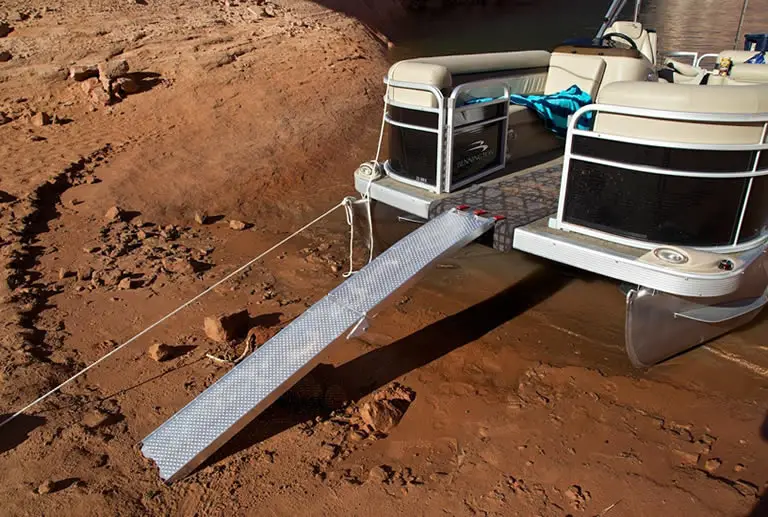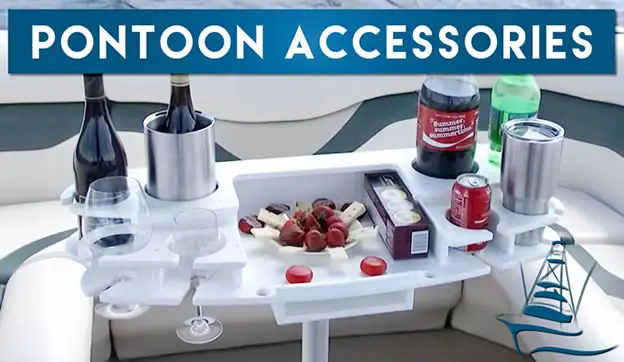Pontoon boats are shallow water vessels that lend themselves well to a number of recreational pursuits from partying and water-skiing to fishing. But what if you want to have a picnic on the beach or go strolling along the shoreline. How do you get to land when there is no marina – is it ok to beach a pontoon boat?
Contents
Is It Ok To Beach A Pontoon Boat?
It is perfectly safe to beach a pontoon boat on most types of terrain as long as you fully trim the motor so the prop is out of the water.
Mud, sand and flat stones offer great surfaces to beach a pontoon boat on. Gravel, or ground with sharp objects, should be avoided as the pontoons will likely get damaged.
You will also need to know how get the pontoon back in the water when you are ready to resume your journey.
Where to safely beach a pontoon boat
Pontoon boats are a more versatile vessel that many people give them credit for being. Although a pontoon boat party is the first thing many people associated with this type of shallow water vessel a pontoon is much more than that.
Being more than just a party boat, a pontoon boat can be used for some really great recreational activities not all of which involve staying on the water!
With its shallow draft a pontoon boat can go into some very shallow waters that other boats would struggle to navigate, but the sturdy pontoons also allow you to beach the boat when the water runs out. This shallow draft, along with the strong aluminum hull means you can easily, and safely, run a pontoon boat ashore without having to worry about doing any damage to the vessel.
If you fancy a picnic on the beach, want to hitch a tent for some camping by the water or simply want to explore the nearby land then you don’t always need a marina or dock to get ashore when you are on a pontoon boat.
As I’ve already mentioned, it is perfectly safe to beach a pontoon boat but is it safe to beach it on any surface or are there some places you shouldn’t try to run ashore?
It is perfectly safe to beach a pontoon boat on a sandbar, a sandy beach, a mud bank or a flat stone beach or similar ground with a flat surface. However, it is probably best to avoid beaching the boat where small gravel or larger stones are present as they can be sharp and cause damage to the pontoon tubes.
Although some pontoon boat owners will run their boats up onto gravel banks , they only do if the boat has a light load and only for short periods.
Personally I would never beach a pontoon boat on gravel or similarly “spiky” ground unless it was completely necessary and the boat did not have passengers or much weight onboard. I would also ensure the boat stayed out of the water for as short a period of time as possible.
Why avoid people and weight on a pontoon boat that is beached on gravel or similar spiky ground?
Well, the added weight of people can all too easily grind the pontoons down into the gravel which can result in tiny puncture holes forming. In fact, even the wake of passing boats can cause this to happen. Pontoon tubes are hollow though they are sometimes filled with air to check for leaks. If you get a hole in one, or both, of the pontoon tubes water will starting getting in.
Water in the pontoons makes the boat perform poorly and could even lead to your pontoon boat sinking or taking a nosedive.
How to beach a pontoon boat in 4 steps
Below is a step by step process for safely and easily beaching your pontoon boat.
4 Simple steps to beaching a pontoon boat:
1. Make sure the path is clear as you approach slowly
Be absolutely sure that there are no obstacles in your way as you approach the area where you intend to beach your pontoon boat.
Reduce your speed significantly. Never try to run ashore at speed.
You will damage your boat and will run the very real risk of injuring people onboard as they are jostled about by the impact.
2. Trim the motor
As you enter shallower water areas begin to trim your motor. You do not want the prop getting damaged on the ground.
As you approach the sandbar, beach or area where you intend to run your pontoon boat ashore, disengage the motor completely and allow the boat to gently drift onto the ground.
This takes a little getting use to as in the beginning you will either take the run-up too fast and bang onto the ground or take it too slow and fall short of a proper “beaching”.
After a few attempts you will be an expert though so don’t worry too much about this.
3. You may need to physically pull the boat further onto land
You should always have a rope on your pontoon boat so you have a two line should you ever need it.
With this rope attached to the boat. pull your pontoon boat further up the beach so les of it is in the water. This will prevent the boat from drifting away (though you can also use the anchor as you will see).
If you don’t have a rope onboard, use the anchor line.
This is not always necessary but sometimes you will find that you need to pull the boat further up onto land.
You can also push it from the back but this defeats the purpose of beaching the boat as you will get wet.
4. Set an anchor
It is a good idea to anchor your boat even though it may be at little risk of drifting away because it is so far out of the water. But, its better to be safe than sorry and if you use an anchor you do not have to pull your boat so far onto land.
Be sure to anchor the pontoon boat correctly, using the appropriate pontoon boat anchor for the ground your boat is beached on, before you leave it unattended.
Some pontoon boat owners will pull the boat completely out of the water and further onto ground, especially in fine sand or mud where the boat moves more easily. This is not such a good idea!
It is much better to leave a portion of the stern of the pontoon boat in the water and simply rely on the anchor to stop it from drifting away.
This makes it easier to get the boat back in the water when you are ready to resume your boating activities.
As long as the front end of the boat is on the ground and there is enough clearance to get ashore without getting wet your pontoon boat is in a good “beached” position.
If you do not want to use an anchor, as some pontoon boat owners do not want the hassle of anchoring the boat, then you will need to pull the boat completely out of the water. If you don’t do this you run the risk of it drifting away (which of course will happen when you aren’t looking or have just stepped away from the boat for 5 minutes).
In my opinion taking an extra 2 minutes to set an anchor is well worth the piece of mind it offers even if you don’t need it.
Regardless if you choose to set the anchor or not, you should always have an anchor on board as you never know when you will need one. I keep two anchors so I can double anchor the boat when needed.
Now, before you get ready to enjoy your short excursion on land have you thought about how you will get off the boat?
Be sure you have a boarding ramp onboard
Be sure you have some type of boarding ramp on board, (I prefer the term “gangplank” because I’m old school and I like to think of myself as a pirate ?☠️). A good quality boarding ramp is an essential piece of kit if you want to beach your pontoon boat as are some other key pontoon boat accessories.
When you beach the pontoon boat, the deck of the boat will be a few feet above the ground. If you don’t want to have to jump down from the boat and then climb back up again you will need some form of ramp.
Obviously this is a necessity if kids and older people are onboard.
How to get a beached pontoon boat back in the water
Once you have enjoyed your “land lover” time (it’s the pirate in me coming out again ?) you need to know how to get your pontoon boat back on the water. Although this is pretty straightforward it can be a bit of a “push” (excuse the pun) if you have to do it on your own.
So, it all starts with a few volunteers (someone has to get wet!).
Have most of the passengers embark and ask them to stand at the back of the boat so all that extra weight is at the water-end of the pontoon boat.
Then you, and hopefully one or two passengers who agreed to help, simply push the boat back into the water. Push it far enough in to the water that the the prop can be lowered just enough to power the boat and reverse it back further into deeper waters.
Now you can see why leaving a portion of the back of the pontoon boat in the water is such a good idea.



